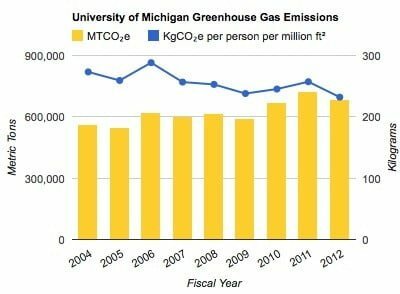 The University of Michigan's normalized greenhouse gas emissions fell seven percent year-on-year, according to the college's latest sustainability report.
The University of Michigan's normalized greenhouse gas emissions fell seven percent year-on-year, according to the college's latest sustainability report.
From financial year 2011 to FY 2012 the metric fell from 257 to 232 kilograms of CO2e per person per million square feet.
The college's absolute emissions fell six percent year-on-year, according to the report. In FY 2012 the university released 684,398 metric tons of carbon dioxide equivalent, compared to 728,024 MTCO2e in FY 2011.
The results represent something of a reversal from performance between FY2010 and FY2011, when the college's greenhouse emissions jumped 5.4 percent. UM's yearly greenhouse emissions from FY 2006 to FY 2009 were lower than its emissions in FY2012.
The college says that while "extensive growth and new construction" challenged it on an overall reduction in emissions, its greenhouse gas emissions were mitigated by a range of actions including an expansion to its North Campus Chiller Plant. The expansion helped UM avoid electricity purchases that would have added more than 1,400 metric tons of carbon dioxide emissions. The college also added four LEED-certified buildings; built wind, thermal and solar energy projects; and undertook energy conservation measures that mitigated another 1,000 metric tons per year.
The university's goal is to reduce its greenhouse gas emissions to 510,000 MTCO2e per year by 2025. This would represent a 25 percent reduction from 2006 levels.
The intensity of carbon emissions from UM's vehicle fleet fell eight percent over the course of the year, from 1 kg of CO2e per trip in FY 2011 to 0.92 kg of CO2e per trip in FY 2012. The FY 2012 figure was the university's lowest since tracking began in 2006. UM needs additional reductions of 11 percent to reach its goal of a 30 percent reduction in intensity by 2025 over 2006 levels.
The fleet now includes hybrid and biodiesel fuel buses, the college says.
 The university's absolute energy use jumped three percent year-on-year, from 7.17 trillion BTUs in FY2011 to 7.41 BTUs in FY2012. Over that time period the college's normalized energy use stayed roughly the same.
The university's absolute energy use jumped three percent year-on-year, from 7.17 trillion BTUs in FY2011 to 7.41 BTUs in FY2012. Over that time period the college's normalized energy use stayed roughly the same.
In May last year, UM said that its then-new modular data center could save the school $600,000 a year in energy bills. The data center houses high-performance computing equipment in a compact space the size of several shipping containers. It also uses outdoor air instead of expensive, industrial air conditioners to cool equipment. The data center's plans were announced in 2008, at which time savings estimates stood at $500,000 a year.
The university's C.S. Mott Children’s and Von Voigtlander Women’s hospital building was last year awarded LEED Silver certification by the US Green Building Council. The project recycled 86 percent of construction waste and operated construction equipment on biodiesel fuel, and the building includes a green roof with a natural storm-water management system. This facility joins the three existing LEED-certified buildings on campus, the report says.
The university's waste production increased six percent year-on-year, from 12,335 metric tons in FY2011 to 13,061 in FY2012, following three consecutive years of decline in this metric. The college has a goal of reducing its waste production by 40 percent over 2006 levels by 2025. The school currently needs to divert an additional 39 percent to reach its goal.
Initiatives instigated since 2006 include waste programs in student dormitories, zero waste events and composting.
UM also is currently halfway to its goal of sourcing 20 percent of the food served on campus in accordance with its sustainable food purchasing guidelines by 2025.
The college's funding for sustainability research almost tripled since 2003, from around $22 million dollars to around $61 million in 2012, according to the report. However, year-on-year funding for sustainability research dropped by about $1.5 million. UM recently launched a new minor course in sustainability.
The University of Michigan announced a series of green initiatives worth a combined $14 million in 2011. These included the purchase of 37 hybrid vehicles, including seven hybrid buses; the installation of a solar array on its North campus; and geothermal heating and cooling for a new golf center.